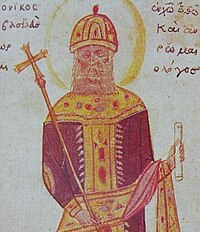Andronicus II Palaeologus
| Andronikos II Palaiologos Ἀνδρόνικος Β' Παλαιολόγος |
|||||
|---|---|---|---|---|---|

Painting of Andronikos II
|
|||||
| Emperor of the Byzantine Empire | |||||
| Reign | 11 December 1282–24 May 1328 | ||||
| Coronation | 12 December 1282 | ||||
| Predecessor | Michael VIII Palaiologos (alone) | ||||
| Successor | Andronikos III Palaiologos | ||||
| Born | 25 March 1259 Nicaea, Byzantine Empire |
||||
| Died | 13 February 1332 (aged 72) Constantinople, Byzantine Empire |
||||
| Spouse |
Anna of Hungary Yolande of Montferrat |
||||
| Issue |
Michael IX Palaiologos Constantine Palaiologos John Palaiologos Theodore I, Marquess of Montferrat Demetrios Palaiologos Simonis, Queen of Serbia Irene Palaiologina, Sebastokratorissa of Thessaly (illegitimate) Maria, Khatun of the Golden Horde (illegitimate) |
||||
|
|||||
| House | House of Palaiologos | ||||
| Father | Michael VIII Palaiologos | ||||
| Mother | Theodora Palaiologina | ||||
| Full name | |
|---|---|
| Andronikos II Doukas Angelos Palaiologos |
Andronikos II Palaiologos (Greek: Ἀνδρόνικος Βʹ Παλαιολόγος; 25 March 1259 – 13 February 1332), usually Latinized as Andronicus II Palaeologus, was Byzantine emperor from 11 December 1282 to 23 or 24 May 1328.
Andronikos II was born Andronikos Doukas Angelos Komnenos Palaiologos (Greek: Ἀνδρόνικος Δούκας Ἄγγελος Κομνηνός Παλαιολόγος) at Nicaea. He was the eldest surviving son of Michael VIII Palaiologos and Theodora Palaiologina, grandniece of John III Doukas Vatatzes.
Andronikos was acclaimed co-emperor in 1261, after his father Michael VIII recovered Constantinople from the Latin Empire, but he wasn't crowned until 1272. Sole emperor from 1282, Andronikos II immediately repudiated his father's unpopular Church union with the Papacy, which he had been forced to support while his father was still alive, but he was unable to resolve the related schism within the Orthodox clergy until 1310.
Andronikos II was also plagued by economic difficulties. During his reign the value of the Byzantine hyperpyron depreciated precipitously, while the state treasury accumulated less than one seventh the revenue (in nominal coins) that it had previously. Seeking to increase revenue and reduce expenses, Andronikos II raised taxes, reduced tax exemptions, and dismantled the Byzantine fleet (80 ships) in 1285, thereby making the Empire increasingly dependent on the rival republics of Venice and Genoa. In 1291, he hired 50–60 Genoese ships, but the Byzantine weakness resulting from the lack of a navy became painfully apparent in the two wars with Venice in 1296–1302 and 1306–10. Later, in 1320, he tried to resurrect the navy by constructing 20 galleys, but failed.
...
Wikipedia
